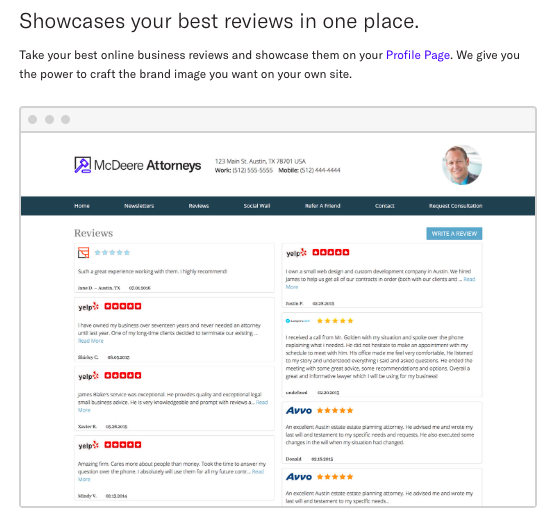Something you’ve been dreading has happened: you received a bad online review. Whether it’s your Yelp page, Facebook Business page or Google My Business page, the damage is done. And it’s public record. Worst of all, the review only tells one side of the story, leaving you, the (hopefully) innocent business owner, to deal with the fallout. Wondering how to handle a bad online review? Read on.
Before we get into the weeds, we want to encourage you not to despair; these things happen to pretty much every business from time to time. As long as you take the right approach, you can still maintain your reputation. Sometimes your response to the situation can even improve it.
When you get the notification that a not-so-flattering review came through, take a deep breath and remember:
- that bad online reviews happen,
- it’s not the end of the world,
- there are plenty of things you can do about it.
While you can always let a negative review be—and that’s sometimes the best course of action—you can also reach out to the reviewer, establish a genuine relationship and work to change their perspective.
Remember, the goal of reaching out to a negative reviewer is to show other readers that you’re a concerned business owner who listens to customers. If you get them to remove or change it, that’s the icing on the cake. Now let’s get started on how to handle a bad online review the right way.
 Step 1: Decide if the Review Needs a Response
Step 1: Decide if the Review Needs a Response
Sometimes reviews aren’t all that bad, and other times they’re outright vicious. Reviews that are factual but negative and include minor complaints can be ignored. If you feel you must post something, keep it short, thank them for their feedback and leave it at that.
But sometimes you’ll get that person who really seems to go out of their way to make your day miserable. You know the type. They write in all caps, haven’t bothered to use their real name or picture, have plenty of typos and then copy and paste the same slanderous statement on every review site out there. Ouch.
For all-out rants like these, rely on your best judgment. These scenarios may help you decide your course of action:
- If what they’re saying is completely false, some platforms allow you to have it removed—for example, Google’s policies forbid reviews that are fake, off-topic, defamatory or include personal attacks. Search out the removal policies for the platform in question to see if this applies to you. Failing that, you can either publicly reply and (politely) debunk the falsehoods, or simply reply with a “thanks for your feedback” and move on.
- If what they’ve posted is mostly true and there is some wrongdoing on your part, this might be one to publicly reply to. Be careful not to get into a he said/she said scenario.
- If what was posted is true and it’s something that’s a genuine concern, own it and commit to changing. Then follow through and reach back out again at a later date.
If your strategy on how to handle a bad online review is to get it taken down, remember that reviews are more than likely going to stay online. While you can try disputing a review, don’t rely on it as your only strategy. Depending on the platform and the nature of the dispute, you may need significant evidence for the removal to actually happen.
For example, Yelp has guidelines on what reviews are appropriate and how to report those that are inappropriate. Again, just reporting a review doesn’t guarantee it’ll be removed.
Step 2: Gather the Facts and Collect Your Thoughts
So you’ve read the review, determined that it needs a response, and now it’s time to reply. But wait! Don’t reply in the heat of the moment. You’ll need to be calm and level-headed when you’re figuring out how to handle a bad online review.
First, take some time to recall the situation or get input from others involved. Jot down notes about conversations you’ve had with the customer, their frustrations, dates and times you worked with them. In short, make sure that you’ve got the story straight on your end.
Then, when crafting your reply, follow these steps:
- Thank this person for bringing this to your attention.
- Address legitimate concerns brought up in the review, and work to constructively resolve the issue.
- Stay calm. Leave emotions out to help de-escalate the situation and show yourself as a level-headed professional.
- Put a name with your reply, as well as a phone number or email address so they can get in touch if necessary, or ask that they direct message you if the platform allows it.
Step 4 accomplishes two things. First of all, if everything goes as intended, you can reach a resolution and get the review changed, updated or removed. Second, and most importantly, showing that you’ve replied to a review lets other readers know that you care about delivering customer satisfaction, even when things aren’t so positive.
Step 3: Reply Privately
If you’ve chosen to act on the review rather than let it be, you face another choice: do you reply publicly, privately or both?
Sometimes a minor issue can be resolved with a quick phone call or email. If you have the ability to do this and you feel that reaching out to this person directly will be the best approach, go for it. It all depends on how comfortable you are with this approach, how well you can take a tongue lashing without getting angry, and how good of a rapport you have with the reviewer.
Sites like Yelp provide a way for business owners to reply directly to reviewers. Use this method for minor issues and be genuine in your response.
When replying privately, use your best judgment, but if a resolution has been reached, feel free to mention to the person that you’d appreciate it if they would update their review accordingly.
Most of all, don’t ask them to take it down. This can feel pushy and come off as an attempt to sweep things under the rug. However, having them update their review lets others know you are dedicated to your customers as they see a conflict resolution play out in full.
Step 4: Reply Publicly
Sometimes you might not have the luxury of being able to reply offline, or you may choose to respond publicly instead of privately. This can have benefits and drawbacks.
Public replies can be bad because they can easily trigger the reviewer to continue to reply in an even worse manner. Some people don’t want a resolution and you can’t fix that. That’s why it’s important to decide if the reviewer is just letting off steam or if there’s a valid complaint that needs addressing.
On the other hand, public replies provide an opportunity to show others reading the reviews that you care enough to try and remedy the situation.
With public replies, winning an argument with a frustrated customer is difficult, and it’s not the goal you should be working toward. Instead, aim for a resolution that satisfies the complaint, remedies your online reputation and doesn’t lash out at the reviewer. In your reply, remember to:
- Keep things professional.
- Don’t get personal.
- Address legitimate concerns.
- Keep it short and sweet.
When figuring out how to handle a bad online review, it’s important for you to provide a way for the reviewer to get in touch with you. Include a name and phone number or email where you can discuss the issue further or help provide a resolution.
Best Practices
While each review site is different in subtle ways, there are some best practices on how to handle a bad online review:
- Even with the worst of the worst, thank the reviewer for reaching out to you.
- Don’t lash out. Even if you’re right, it won’t end in your favor. Your goal is to defuse the situation, not win an argument.
- In general, use the same logic you would apply to face-to-face interaction.
- Work to find a resolution offline. A problem is more likely to escalate online and become more permanent.
- Don’t respond while you’re angry. It won’t end well.
- If there are elements of a negative review that the reviewer isn’t mentioning that help your case, consider including them in your reply. Maybe you attempted to remedy the situation already and this person is here to rant. Defend yourself, but only if you can do so without being aggressive.
- Address legitimate concerns only. Issues that are within your control and are negative reflections on your business are worth addressing. You can waste a lot of time on people who will never be happy.
Parting Thoughts
- At the end of the day, people can be plain mean, even if you have the best intentions and the right circumstances to proactively address an issue. Not every angry person will have a change of heart.
- Reminder: don’t ask people to take a review down. This could make things worse for you, especially if you haven’t resolved anything for that person. You can ask them to update their review if the situation has been resolved.
- Before responding, make sure that you get all the facts straight. Know the situation inside and out, and be prepared to offer up ideas to remedy a problem. Some people need to vent and let off steam, and you’re better off just taking it. Other times, if there’s a problem with your business worth taking to heart, thank the customer for bringing it to your attention.
- Lastly, after you’ve addressed a problem and the individual is satisfied, you can ask for an update to the review to reflect your efforts. They might update it or they might not. If they do, wonderful! If not, at least your business is on record as having replied to the reviewer.
Having trouble getting reviews?
If you have lots of positive reviews, one negative review will barely affect you at all. However, if you have only a few reviews on a particular site, one bad one can tank your rating. That’s why it’s important to have not just positive reviews, but enough positive reviews.
OutboundEngine can help you generate more reviews by finding advocates in your network, helping you ask for reviews, and gathering all your reviews on one page.
We know it can be uncomfortable asking for reviews, so we even have email templates with the text ready to go for you, among our many other review features.
Whether it’s online reviews or digital marketing, OutboundEngine is here to make your life simpler. Check out our software and see how it can work for you.



![Better Email Etiquette Equals Better Marketing Results [16 Rules]](https://www.outboundengine.com/wp-content/uploads/shutterstock_411184843-1-400x250.jpg)

